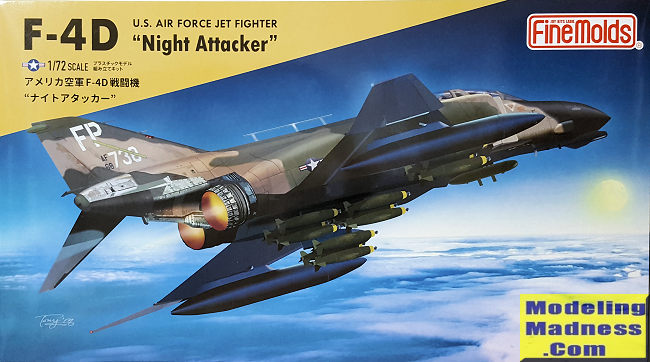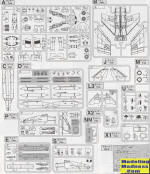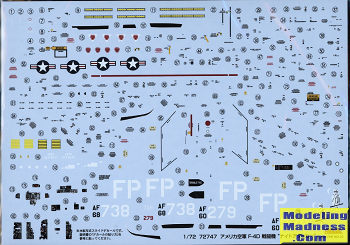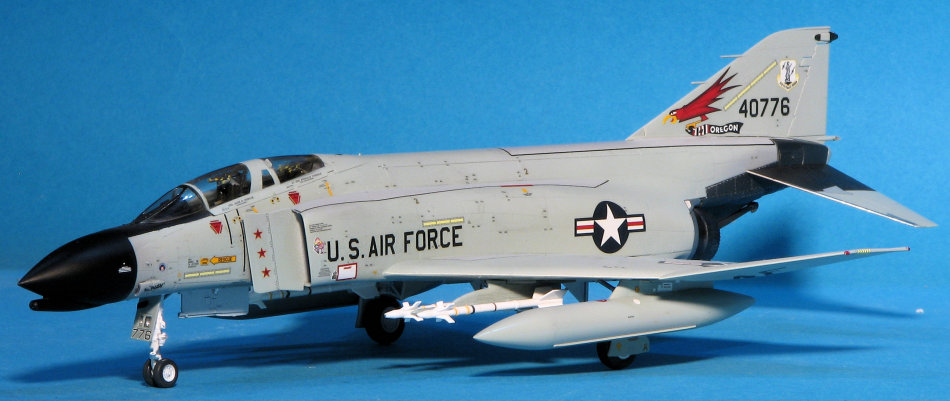
Fine Molds 1/72 F-4D 'Night Attacker'
| KIT #: | 72747 |
| PRICE: | 3280 yen on sale |
| DECALS: | Two options |
| REVIEWER: | Scott Van Aken |
| NOTES: | 2024 release |

| HISTORY |
The McDonnell Douglas F-4 Phantom II is an American tandem two-seat, twin-engine, all-weather, long-range supersonic jet interceptor and fighter-bomber originally developed by McDonnell Aircraft for the United States Navy. Proving highly adaptable, it entered service with the Navy in 1961 before it was adopted by the United States Marine Corps and the United States Air Force, and by the mid-1960s it had become a major part of their air arms. Phantom production ran from 1958 to 1981 with a total of 5,195 aircraft built, making it the most produced American supersonic military aircraft in history, and cementing its position as a signature combat aircraft of the Cold War.
The success of the Navy's F-4B and the delays in getting the F-111A into service led the USAF to order the F-4C (originally the F-110A) into production. The aircraft differed little from the Navy's version aside from large lower pressure tires, and some USAF avionics. In fact, USAF training units borrowed 36 F-4Bs in order to qualify air crew and maintenance technicians. The type did fairly well in Vietnam and went on to be the basis for future upgraded variants. This aircraft was replaced with the F-4D which, among other things, had even newer avionics along with upgraded engines. One of the big 'improvements' was the ability to use Falcon missiles. These weapons proved to be unsuitable for air to air combat, being designed to shoot down slower bombers. Like other variants, once replaced in USAF units, the F-4D soldiered on with ANG units until near the end of the F-4s service life.
During the Vietnam war, the 497th TFS was tasked with nocturnal missions, mainly against targets on the Ho Chi Minh trail. As such, they had the undersides painted black in hopes that this would make them more difficult to see against the night sky.
| THE KIT |
 Fine
Molds initial F-4 releases were of the Japanese F-4EJ but they have now put out
other versions. This is the F-4D and it is quite welcome. Now this isn't the
only F-4D by far as the type has been previously kitted by Monogram, Fujimi, and
Hasegawa just to name the three biggies. Those kits are still available and
still make nice models. However, this one has raised the bar in terms of
engineering if nothing else.
Fine
Molds initial F-4 releases were of the Japanese F-4EJ but they have now put out
other versions. This is the F-4D and it is quite welcome. Now this isn't the
only F-4D by far as the type has been previously kitted by Monogram, Fujimi, and
Hasegawa just to name the three biggies. Those kits are still available and
still make nice models. However, this one has raised the bar in terms of
engineering if nothing else.
It should come as no surprised that this kit has pretty much the same sprues as their previously previewed Iranian F-4D. Here are some of the interesting features. In the cockpit, the side consoles are separate inserts to take into account the various differences between variants. There is full intake trunking back to the first compressor stages. Not surprising is that the forward fuselage is separate. The main fuselage is a single piece with an upper deck insert so no worries about seams. There is also a detail piece for the engine aux intake doors.
Wings are a lower section that includes most of the lower fuselage with upper halves and separate wing tips. There is no folding wing option with this kit. The wing underside has inserts for where the cat attachment points would be on the naval versions. Two different radomes are provided, one with and one without the IR seeker.
The metal portion of the rear fuselage is a separate item with an insert for the very aft portion. Again, to eliminate some of the usual seams one sees in other kits. You are provided a clean fin and can attach the RHAWS antennas if needed. Horizontal stabs are interlocking to help with alignment.
 Inner
main gear doors include a portion of the gear well so attaching these will be a
breeze. You are provided missile pylons and three drop tanks. However, there are
no weapons, those being offered in a separate weapons pack and frankly, you
really need to snag one from either Fine Molds or even Hasegawa if you want any
sort of weapons load. Finally, you can do canopy open or closed with a separate
closed canopy piece. There is an additional sprue with this kit for a LORAN
antenna on the spine.
Inner
main gear doors include a portion of the gear well so attaching these will be a
breeze. You are provided missile pylons and three drop tanks. However, there are
no weapons, those being offered in a separate weapons pack and frankly, you
really need to snag one from either Fine Molds or even Hasegawa if you want any
sort of weapons load. Finally, you can do canopy open or closed with a separate
closed canopy piece. There is an additional sprue with this kit for a LORAN
antenna on the spine.
Instructions are superb providing a lot of information. Color info is provided in both Gunze and FS 595. There are two options, both from the 497th TFS with standard SEA camo on the upper side and the light grey undersides replaced with matte black. Decals are well done and you have the benefit of a ton of stencils that will need to be attached to the airframe, though you can leave off the underside ones.
| CONCLUSIONS |
As much as I like the Hasegawa F-4s, this line from Fine Molds is just that much better. It is nicely engineered and while not a toss-together kit, will provide you with a great model when done. Below is an image of their F-4C that I completed a few months back.

March 2024
Copyright ModelingMadness.com. All rights reserved. No reproduction in part or in whole without express permission from the editor.
If you would like your product reviewed fairly and fairly quickly, please contact the editor or see other details in the Note to Contributors.